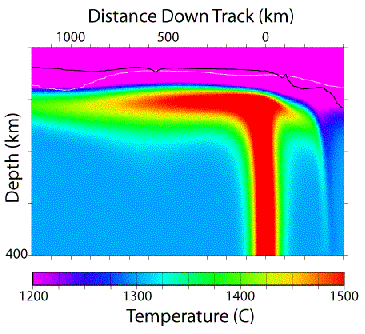During the early stages of studying the Columbia River Flood Basalts, scientists came up with a plethora of hypotheses about what caused the initiation of volcanism in this flood basalt province. While some of these ideas have since been dismissed or disproven, two are still relatively popular with one receiving the most support from the scientific community.
One of the mechanisms proposed is an impact crater, which could have created melting due to a transfer of kinetic energy and heat from the impactor to the surrounding crust (Alt, et al, 1988). This idea was dropped because of a lack of ejecta and impact breccia near the proposed site of impact.
Another proposed mechanism is that shearing of the North American Plate, caused by contact with the Pacific Plate, could have produced the basalts (Dickinson, 1997). This idea appears not to be well supported.
A third idea is that rifting occurred in an area where the mantle was anomalously warm from some source other than a mantle plume. The combination of the pre-warmed mantle and extension could produce basalt eruptions (White and McKenzie, 1989). This, too, did not gain popularity as a valid mechanism for initiation of the Columbia River Flood Basalts.
The first hypothesis that has widespread support is the idea that the basalts are caused by extension occurring in the back arc region of the Cascades Magmatic Arc (Smith, 1992). Hart and Carlson (1987) proposed that a rotation of the Juan de Fuca ridge relative to the coast of North America at 20 Ma decreased the compressional stress on the Columbia Plateau. They argue against a plume by stating that it would be unlikely for a plume to penetrate a cold, subducting slab. They also add that volcanism occurred at the same time along a 400 km line, which does not support a plume source. Catchings and Mooney (1988) find support for the back arc extension hypothesis in their seismic refraction profile data, which shows Eocene extension in the area with a central graben that accumulated subbasalt sediments.
The figure above from Smith, 1992, shows the stages of back arc extension producing magmatism.
Arguments against this hypothesis are that it doesn’t explain why the eruption of the basalts was short lived, or how the enormous volume of basalt was produced. In addition, very little extension occurred in the Columbia Plateau. Neogene extension totals less than 5 km, or 1% (Hooper and Conrey, 1989). However, more volcanism occurred in the Columbia plateau than in the more extended Oregon Plateau. Thus, the volcanism does not match the pattern of extension (Hooper and Hawkesworth, 1993).
The most popular hypothesis to explain the initiation of the Columbia River Flood Basalts is the Yellowstone Hotspot mantle plume. The ages of the plume track in the Snake River Plain correlate with the age of the Columbia River Flood Basalts (Armstrong, et al, 1975). Various authors have proposed that a plume could bring enough molten material to the surface within the short period of time recorded in the Columbia River Flood basalts. Further support for the plume hypothesis comes from isotopic and incompatible trace element data. The Clarkston and Saddle Mountain flows have similar Light Rare Earth element signatures to those of Ocean Island Basalts (Hooper, 1986). This suggests a similar hotspot source.

This figure from www.mines.utah.edu shows a computer model of a plume rising to the base of the lithosphere.
One of the main criticisms of the plume hypothesis is that the Columbia River Flood Basalts erupted significantly north of the Yellowstone Hotspot track (Hooper, 1986), as can be seen in the figure below from www.cotf.edu.
To explain this, Geist and Richards (1993) suggested that the plume was deflected to the north by the subducting Juan de Fuca slab. As the slab entrained the plume, the plume heated the already warm, young slab, and eventually broke its way through.
Figure from Geist and Richards, 1993
While other hypotheses are still supported, the most common hypothesis is that the initiation of the Columbia River Flood Basalts was caused by a mantle plume.
To learn about the current controversy click here
return to home